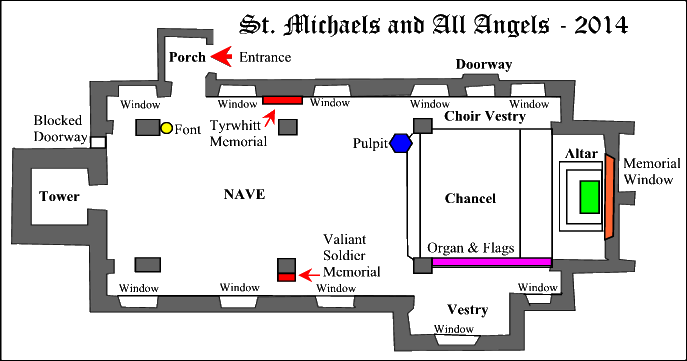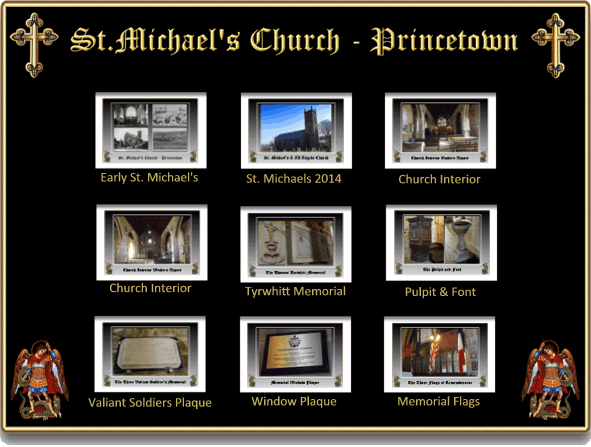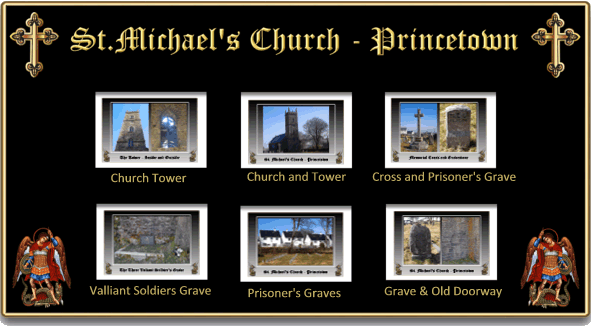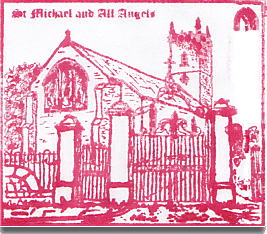
Back in the early 1800s Sir Thomas Tyrwhitt had amongst others, a dream that Princetown would have a prison along church to serve the growing community. The prison was to house prisoners of war from the Napoleonic war and construction of this project began in 1806. However, it was several years before work on the church commenced and as will be seen later it was amidst some controversy.
Today the church is classified as redundant and since 2000 has been placed in the care of The Churches Conservation Trust. However, just because the place is no longer a place of regular worship it does not mean that there is not plenty of fascinating history attached to it. Firstly, the church is unique insomuch as it is the only church in the UK whose structure was built by French and American prisoners of war.
To see the beginnings of St. Michael’s church you need to back in history to the year 1805 when Sir Thomas Tyrwhitt has drawn up plans for the construction of the War Prison and a chapel that was to be known simply as ‘Dartmoor Church’. The church was intended to serve the local community that was expected to flourish alongside the War Prison. By the November of 1811 work had not even started on the church and so the Prison Board invited the then Governor, Captain Isaac Cotgrave for ‘tea and biscuits’. Having confirmed the Board’s concerns Cotgrave was then instructed to give his best estimate as to the number of people the church should accommodate once built, this transpired to be between five and six hundred. In the January of 1812 Captain Cotgrave was granted permission by the Lord Commissioners of the Admiralty to construct a church and clergy’s residence under the supervision of John Walters who was the Foreman of the Works at Dartmoor and was to act as the architect. Walters’ brief was basically to draw plans for a simple church and clergy’s residence as economically as possible. On the 12th of February 1812 Captain Cotgrave received instructions to commence building but on the 22nd of the same month those orders were rescinded whilst the construction costs were examined. However this deliberation did not take long and on the 19th of March 1812 the go ahead for work to start was given
The church was to be large enough to cater for five to six hundred people and the house large enough for a clergyman and his wife. Both buildings were to be constructed of granite of which there was an ample local source and the labour would be provided by the French prisoners of war. Internally the church was to be fitted out with benches along with some enclosed seats for the use of senior officers and their kin. The churchyard had to be one and a half acres in size with an enclosed parade ground for the troops.
Accordingly Walters submitted his plans to the board who then despite their original demand for economy decided the costs were too frugal. He was then told to rethink his proposals and additionally to include a belfry for one bell. In the November of 1812 the board, probably much to the frustration of John Walters, decided that instead of the belfry a proper tower should be built.
By the November of 1812 there needed to be a decision on what materials were to be used for the roof, the choice being between lead and slate. As it would be £477 cheaper to use slate this option was chosen. Over the next two years the external construction work was slow due to various problems amongst which was the inability of the local supplier to provide the roofing lead.
Up until the June of 1814 the labour was, as noted above, provided by the French prisoners of war who incidentally were paid the handsome sum of 6d a day. As hostilities with the French had ended these men were repatriated and so the labour source was replaced by American prisoners of war. By this time there was a new Governor at the war prison, one Captain Shortland who was told to use of the Americans who were carpenters, masons or blacksmiths. These craftsmen were left in no doubt that if any of them attempted to escape the entire workforce would forfeit their pay and no further prisoners would be given the privilege of working on the project. The temptation of freedom was too much for one prisoner who made good his escape which resulted in, as promised, all prison labour being withdrawn and replaced by militiamen.
With the signing of the Treaty of Ghent in 1814 the War of 1812 was over and plans for the repatriation of the American prisoners were set forth. By the April of 1815 the first batch of American prisoners were released and by the July of that year all of the Americans had been returned home. However at the same time another contingent of French prisoners of war were brought to Princetown, many of which were coming back for the second time having been previously released. By the February of 1816 all prisoners of war had been released and the gates firmly closed on the prison. So one could say that the idea of providing a place of worship for the prison garrison was a complete waste of money for all concerned as the church was only finished just before everyone left Princetown.
The 1st of November of 1815 saw the burial ground officially consecrated by the Chaplain to the Bishop of Exeter – Mr. Thomas Turner.
Disregarding the history of the church’s’ construction it is now appropriate to step back in time to meet the Rev. James Holman Mason alias the ‘Bishop of the Moor’. Initially he was the curate at Lydford church but later leased and enclosed six hundred acres of Duchy land near Crockern Tor. Once construction of the prison began the Rev. Mason had been conducting services for the workmen in an old airing shed. It is said that up to two hundred worshipers attended his services. In 1809 he requested that the Prison Board allowed him to use part of the hospital for his services. Not only was this request denied but the Board expressed concern that he was holding services on their property at all. It seems that they had made no plans to provide such a facility for the prisoners and should the militia require such they would appoint an official prison chaplain. Undeterred by the response Mason continued with his ministry holding not only services but baptisms as well. In 1813 the post of Minister at Dartmoor Church came available and being ‘insitu’ so to speak he applied for the job and successfully got it. Although the church was no where near completion the Rev. Mason held his first service at St. Michael’s in the January of 1814 which was followed by two christenings. Around the same time Mason set about the task of equipping the church with the necessary furniture. St. Sidwells church in Exeter had for sale a pulpit and desk which he managed to buy for the princely sum of £22. He also submitted to the Board his design for a font which was approved and the work given to a mason called Winnie. Having a mighty tower to his church meant mason would need a peal of bells and these were ordered. Unfortunately having been cast and in the process of shipping to Princetown they had reached Plymouth docks when peace was declared. So not wishing further expense it was decided to leave them there where they were later hung in the dockyard church of St. Nicholas.
Following the closure of the war prison the church of St. Michael served the surrounding area which meant a much reduced flock when compared to the anticipated five to six hundred worshipers and so its doors were also shut. However in 1831 the local population had increased and so the doors were once again opened for worship and the place re-consecrated.
In 1850 the old prison was reopened to become a normal convict prison which meant that once again Princetown began to flourish as did the church’s flock. In 1860 the church was granted the faculty for performing marriage which meant the full range of services could be held, baptisms, marriages and burials. In 1862 the Rev. Morris Fuller took over the running of the church and eight years later was confronted with disaster when in 1868 a fire virtually gutted the church resulting in the loss of most of its internal fittings and furniture. Over the next eight years the church underwent a process of restoration which was overseen by a Mr. R. M. Fulford. However due to lack of funds this work was not of the best standard and by 1905 the large east wall was in danger of total collapse. Fortunately in 1908 a New York newspaper ran with the story of the church’s plight and how it was American labour that partly build it along with the urgent need for funds. The story was picked up by a Mrs. Slade who at the time was president of the ‘National Society of United Daughters of 1812’. The main concern of this society was to commemorate the American men who lost their lives in the war of 1812. Mrs Slade began an appeal to the three thousand odd members of the society who managed to raise the sum of £250. This money was donated in order for a commissioned memorial window to be installed whilst presumably renovating the east wall at the same time. In the June of 1910 the work was completed and a special service was held to unveil the window. Mrs Slade came over from America as the official representative of the society carry out the unveiling. Other restoration work of this period also involved enlarging the east end, lowering the walls and replacing the roof whilst inserting supporting arcades, all under the auspices of one E. H. Sedding.
“Unquestionably the bleakest place in Devon – not only because of the jail. Princetown lies 1,430ft high and exposed from all sides,” Pevsner, p.695.That is how the section on Princetown begins in his architectural guide for Devon so it should come as no surprise that over the years the church has been subject to the cruellest of Dartmoor weather. A good example of how bleak Princetown can be is shown in the old photograph below of the infamous blizzard of 1891. As a consequence the structure slowly fell into decay until it got so bad that in 1994 it was decided the expense of repair could not be met from church funds. The only option was to declare the church as redundant and put it up for sale. Understandably no buyers were forthcoming which only left the option of demolition. In 2001, almost at the last hour ‘The Churches Conservation Trust’ stepped in and rescued the place from certain destruction. Today like the fabled Phoenix the church is slowly rising from the ashes and is once again slowly and proudly regaining its dignity. Following in a long line of architects John Beauchamp of Benjamin & Beauchamp was in 2011 appointed as the church architect for St. Michael’s. Since the renovation work began the steeple has been restored and the building made Dartmoor weatherproof. Currently work is being carried out on restoring the east window.
In 2013 a memorial service was held in the church to commemorate and remember the American prisoners of war who were interred in the prison two hundred years previous. Once again members of the ‘National Society of United Daughters of 1812’ attended the service along with representatives of the US and Royal Navies, the Lord Mayor of Plymouth, the Deputy Lord Lieutenant of Devon
Today St. Michael’s is encompassed in the West Dartmoor Mission Community and is under the care of the Reverend Nick Shutt. It is still possible to hold the occasional service and events at the church allowing for whatever work is in progress.

A few weeks ago I received an email from Katrina Hurford who is the Marketing Officer, West, for ‘The Churches Conservation Trust’ asking if I could include St. Michael’s church on this Legendary Dartmoor website. As you can now see this I have done but as always it did involve a visit to the church to take some photographs. At present (March 2014) if you visit the church you will see that the conservation work on the east window is well and truly underway as the scaffolding will testify. As you enter the church you are greeted by the font designed by the Reverend Mason and an information desk and collection box. Walking along the north wall there are various memorials the most striking being that of Sir Thomas Tyrwhitt. The memorial depicts the coat of arms with the motto; ‘ME STATE VIREBUNT‘ which translates as “While I stand they flourish.” Considering his plans for Princetown this was a very apt and optimistic motto to use. The inscription on the memorial reads; “His name and memory are inseparable from all the great work on Dartmoor and cannot cease to be honoured in this district.” Along the north wall are five ‘Y’ tracery windows which survive from the original building. On the corner of the chancel stand the pulpit purchased from St. Sidwells church which sports four carvings which represent evangelists.
Unfortunately I was unable to take a decent photograph of the window due to it being obscured both inside and out. However this is the window that the National Society of United Daughters of 1812 donated in 1910. It contains seven panels which depict scenes showing the life of Christ and includes his birth, life, death, resurrection and ascension into heaven. Under is the following inscription; “To the glory of God and in memory of the American prisoners of war who were detained in the Dartmoor war prison between the years 1813 -15, and who helped to build the church, especially of the 218 brave men who died here on behalf of their country, this window is presented by the National Society of United States Daughters of 1812. Dulce est pro patria mori (roughly translates as it is sweet to die for your country).”
The chancel itself still contains various items of furniture from the 1870s the frontals of the choir and vicar’s stall. Fortunately these items were kept following the 1908 -1910 renovations and have now been re-instated. This sadly was not the case with the choir benches, all but one was removed and this now sits forlornly in the vestry. There is also a splendid 20th century altar fashioned in the late medieval style which is enclosed by green curtains at the rear and sides. On my visit the altar had been removed and replaced by a simple table and cross.
On the south side of the chancel is the now defunct two-manual organ which was built by Frederick Tucker of Plymouth. In front of this organ are three memorial flags; a Union Jack (donated by HMS Brilliant), a French Tricolor and the American Stars and Stripes.
On the south wall is another memorial dedicated to ‘The Three Valiant Soldiers’ who in 1853 died in a snowstorm at nearby Soldier’s Pond.

On the west side of the church is the Gothic style tower with its arched windows, from inside the church you can see the metal staircase winding its way up to the top. The magnificence of the tower is best viewed from outside where it steeply climbs up to the heavens. To the north-west of the tower is a large memorial cross which was made by prison inmates and erected in 1912. Prior to this date it was normal practice to bury any prisoners in unmarked graves inside the prison walls. In 1912 there was a change insomuch that the deceased prisoners were buried at the western end of the churchyard. The intent of the memorial cross was to commemorate all the prisoners who died and were buried inside the prison. William Crossing notes how in 1865 the remains of many of these prisoners buried within the prison were actually visible and so Captain W. Stowford collected them up and reburied them in two separate cemeteries, one for the French and the other for the Americans thus creating what today are the memorial cemetaries
About a third of the way along the southern wall of the churchyard is another small grave and this is where the ‘Three Valiant Soldiers‘ are buried. The photograph of their grave on the Soldier’s Pond page was taken in 2009 and as you can see from the photo below the inscription is now totally illegible, hopefully this will be on the restoration list. Originally the inscription read; “IN MEMORY OF, Three Valiant Soldiers, of the 7th Royal Fusiliers, who died on Dartmoor, in a snowdrift 12th Feb. 1853, Corpl Joseph Penton Aged 20, Private Patrick Carlin Aged 23, Geo Driver Aged 27.” It is touching to see from the small bunch of flowers that were beside their grave that somebody still recognises their tragic end.
At the far north western end of the churchyard are four rows of small, simple granite pillars, these are the graves of prisoners who died whilst at Dartmoor prison after 1912. They are simply marked with the deceased initials and the date they died. There are two exceptions, the first lies close to the memorial cross and bears the inscription “R.G.P. 9 – 7 – 46,” and belongs to a borstal boy who was transferred to Dartmoor. Secondly, in front of the rows of convict graves is a lone gravestone that looks as if it should belong with the non prisoner graves. This is not the case as it belonged to a prisoner whose family was the only one to take up the option of providing a proper headstone, its inscription reads; “L.D.G. Died February 22nd 1877. Aged 44 years. My Jesu Mercy.”
The eastern end of the churchyard are where various people associated with the church are buried amongst whom are a Governor of the prison and John Walters the architect, this is also where local parishioners are also laid to rest.

If ever you are in the vicinity of Princetown do not miss the opportunity of paying St. Michael’s and All Saints Church a visit to see for yourself the excellent restoration work The Churches Conservation Trust is doing. The building truly belongs to the heritage of both Princetown and Dartmoor due to its uniqueness and history. It is for this very reason that at great expense the restoration project is underway but funds are still needed to carry on the work. Should you visit the church there is an opportunity to make a much needed donation to the project. Failing that you can visit the trust’s website at the link opposite where you can learn much more about their work and also make a donation.
Finally, someone has provided the church with a letterbox stamp which as always will act as a unique souvenir of the visit. Should you be a letterboxer be sure to take your personal stamp and their is a visitors book in which you can ‘stamp in’.

St. Michael’s letterbox stamp

Cherry, B. & Pevsner, N. 2004. The Building of England – Devon. London: Yale University Press.
Crossing, W. 1989. Princetown – It’s Rise and Progress. Brixham: Quay Publications.
James, T. 2002. Dartmoor Prisoner of War Depot and Convict Jail. Chudleigh: Orchard Publications.
James, T. 2002. About Princetown. Chudleigh: Orchard Publications.
Joy, R. 2002. Dartmoor Prison – Vol.2. Tiverton: Halsgrove.
Sandles, T. 1997. A Pilgrimage to Dartmoor’s Crosses. Liverton: Forest Publishing.
Stanbrook, E. 2002. Dartmoor’s War Prison & Church 1805 -1817. Brixham: Quay Publications.
 Legendary Dartmoor The many aspects past and present of Dartmoor
Legendary Dartmoor The many aspects past and present of Dartmoor

Having been Christened in this church I was pleased it was saved from demolition. However as my parents and grandparents were married here, and then buried in the churchyard, I was sad to see that the graves are not well tended. In addition, can you tell me if there is a record of those buried here. I have a long line of ancestors buried here but couldn’t find many of them.
Family names being Stephens, French and Dashwood. ( I know where my parents and grandparents graves are but not other members).
Thank you.
Shirley Kevern.
A fascinating history of this lovely church, thank you. I try to visit whenever I’m in Princetown and once had the opportunity to chat with some visitors from the USA., who had arrived by coach from their cruise ship. It’s lovely to spend a quiet time inside the building and also amongst the grave stones. Very touching. And I won’t forget to add a contribution for upkeep.